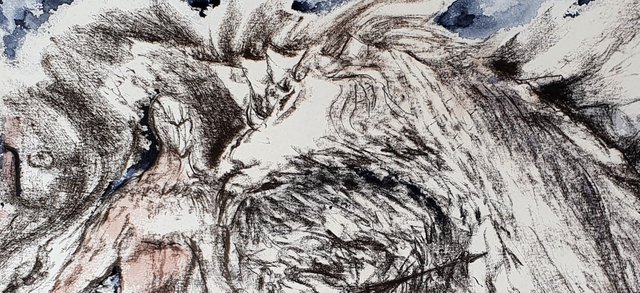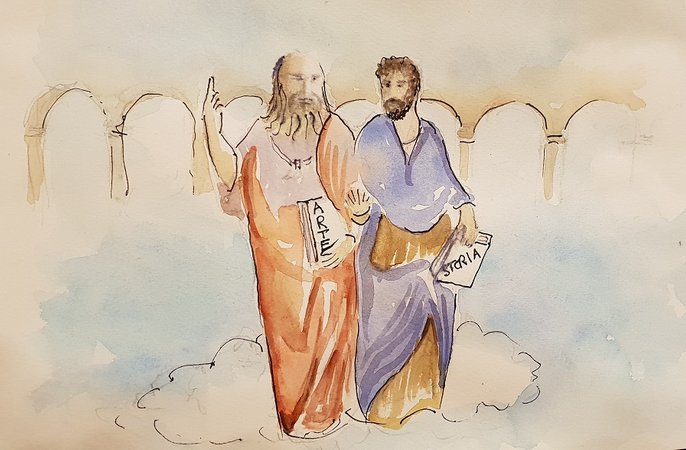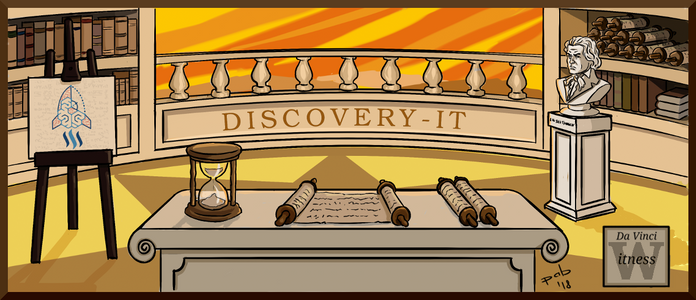Discovery Art&History Presents: Gothic cathedrals

Discovery-it Art&History





Gothic cathedrals

Hello friends, welcome back!
We continue our journey with the fourth issue of our section Art & History of Discovery-it, although once again with sadness in our heart, due to the massive damages caused by bad weather in Italy, which unfortunately have not spared even our authors.
Therefore, the whole editorial staff wishes a quick recovery to them and to all the people hit by this natural disaster.
Now let’s start to warm up the time machine engine, because even today we have to make a big jump back to the thirteenth century, in the Middle Ages, when we will witness radical changes within society: social classes are redefined, economic power is no longer just nobles prerogative and the arts slowly bloom again, especially architecture. The white-mantled warrior monks, Knights Templar, begin the construction of the first Gothic cathedrals, called Notre Dame, incomparable architectural marvels full of dark charm and ancestral mysteries.
We will analyze these wonderful buildings from foundation to the roof, passing through their imposing buttresses and famous decorations that still distinguish them today, namely their amazing stained glass windows and gargoyles.
So make yourself comfortable, another fascinating journey of Discovery-it in the history of mankind is about to begin...


On top and on bottom: Eucharist and Alchemy

In the first half of the XII century, the French area was distinguished by a great cultural brightness. Population was rising and welfare too. The religion thrust was stronger than ever, with a continuous chasing of ways to concretize it.
The political outline wasn’t stable at all, with powerful people of the era needing to assert their prestige, not only with strategical weddings and military campaigns, but - mostly in the ecclesial field - paying for monumental works.
Those diverse needs seem to convey in the birth of gothic architecture, with the aim of revolutionizing forever constructions’ techniques, even if it didn’t bring significant innovations at a conceptual level. [1]
It deals with a new way of assembling pre existent elements, bringing concepts from the norman architecture.
It is rather a new way of assembling pre-existing elements, drawing on Norman and Middle Eastern architecture. The key concept is structure weight redistribution: the recurrent use of cross vaults, rampant and pointed arches, pinnacles and external buttresses [2], allows you to avoid to raise too thick and massive walls, that during the Romanesque period had represented not only an economic limit, but also - and above all - a design constraint. [1]
Cathedrals reach unbelievable heights, just unthinkable a few years before: their bold and unusual shapes seem to point straight to the sky. Through the lightened walls, light can finally emerge and becomes an architectural and artistic element in all respects.
The result is stunning and the movement takes hold throughout Europe.
However, the twentieth century esoteric thought gives us a different interpretation of this phenomenon, according to which it is not a natural evolution of architecture over time, but a precise message left to us by the custodians of an ancient initiatory knowledge [3 ]. It was when the first Templars return from the Holy Land, in fact, that gothic suddenly states itself: the famous order of warrior monks, at the center of many mysteries of history, is the main promoter of this new style.
One after the other, in the Île-de-France region, eleven cathedrals stand, all dedicated to "Our Lady" and located near ancient pre-Christian places of worship, previously consecrated to the "Great Mother" of the druidic and pagan rites. [3]
Buildings layout on the ground reproduces Virgo constellation stars position, while in the crypts below the churches, historians found the so-called "Black Virgins": they are statues or bas-reliefs representing a dark-skinned Mary, which seem to refer exactly to the archaic lunar deities [3] of Africa and the Mediterranean area. In general, Gothic cathedrals symbolism borders dangerously on heresy: mythological creatures, astrological references, revisits of primitive symbols (such as the magic square and the labyrinth), struggle to find a coherent collocation within Christian doctrine; not the same happens in the scholars interpretation of esoteric sciences. [3]
All the various currents of thought, anyway, agree in assigning geometry a preponderant role: in Gothic style, the divine presence is not represented by frescoes or mosaics, but left to be discovered in its perfect proportions. [4]
Under the apparent chaos of spiers, reliefs and colorful stained glass, precise symmetries are concealed, as evidence of a single will at the origin of the multitude of creation; a unique wisdom hidden among the folds of time.
References:
1.[Enciclopedia Zanichelli 1996, a cura di Edigeo - Zanichelli, Bologna, 1996]
2.Glossario termini architettura gotica, di Stefano Torselli
3.[I misteri della cattedrale di Chartres, di Louis Charpentier - Arcana Editrice, Torino,1972]
4.Chartres e la sezione aurea
written by @middleearth

Gothic windows: Mystic light and colors

Counties, fiefs, duchies and marquisates, knights, rulers, wars, crusades, barbarians, popes and the empire in conflict ... These are some of the elements and events that defined the civilization of the late Middle Ages, a century of economic and social transformations. The power summits change, new social classes come up like the rich middle class, new civic identities are born, a prosperous period go through and the artistic panorama is transformed, giving rise to a new and very vast stylistic phenomenon that embraces many fields of art, to valorize even some minor craft such as jewelry, miniaturism and glass works. Gothic .
Gothic art initially arises in northern France, gradually arriving and establishing in the rest of Europe. We find the greatest innovations in architecture, in fact, contrary to the Romanesque style, clear and measured, the architectural study in this case intervenes above all on cathedrals structure. The gothic building is defined according to some typical techniques: pointed arch and ogival ribs that support vaults, the presence of flying buttresses that facilitate and distribute weight, spiers and pinnacles, gables, fretwork lights in the facades rosettes and stained glass windows. The cathedral assumes new dynamic and symbolic spaces, the relationship between height and width changes acquiring a considerable upward momentum, almost to emphasize a detachment from the earth to rise towards the light, then towards God. Space is unlimited, indefinite, thanks also to the presence of huge stained glass windows.
Glass is a Gothic art symbol and it, is thanks to it, that the light -symbolic element of immense value in the Middle Ages- filtered through the colored glass becomes a means of mystical and supernatural expression, as it personifies the divine; it is through it that the faithfuls sought direct connections with God, to defeat the dark dimension typical of sin and evil [3]. The stained glass windows had the task of illustrating to the ignorant and illiterate people the holy texts, in fact there were depicted divine images of saints, prophets, symbols and scenes of the sacred scriptures, but also stories and representations of ancient popular jobs, to pay homage to those who had contributed to the construction and fulfillment of these magnificent monumental works, regardless of the social class of belonging. Even the stained glass realization was closely connected with religious faith; the process itself was based on techniques difficult to learn and uncertain outcome, therefore, this ancient art secrets were reserved for a few expert craftsmen and alchemists, able to treat glass with multiple artifices until it became a precious mineral, which could spread its own light.
References:
- Collana a cura di S. Zuffi, Storia dell’Arte 5, il Gotico. Mondadori Electa, 2006, Milano.
- Collana a cura di S. Zuffi, Storia dell’Arte 3, l’Alto Medioevo. Mondadori Electa, 2006, Milano.
- Luce e colori, il segreto delle cattedrali gotiche
Curated by: @michelacinque


Ancient knowledge, new cathedrals: The Templars and Chartres Cathedral

During the thirteenth-century in Europe, especially in the west part, a precious metal was so scarce that it was considered a very rare commodity: silver.
The most famous mines had been totally exploited, and the unobtainable mineral was prized by the traders of the old continent,when this suddenly appeared on the economic scene in enormous quantities.
"The Knights Templar brought it", people rumored in every corner of the continent, but where they had found it, however, was unknown.
Although the Templars were already in possession of an immeasurable wealth accumulated since the early years of the constitution of the monastic/military order, they used a large part of the precious mineral to self-finance the construction of around one hundred and fifty cathedrals in the same quantity of years, all baptized with the suffix "Notre Dame". They erected massive and majestic buildings full of artistic grace with an innovative style, something new never seen before: Gothic.[1]
We are sure, however, that such wonders were the result of a new, improvised and modern style, rather than an ancient and latent learning finally put into practice?
We can affirm without a doubt that as guardians of an ancient esoteric acquaintance, the Knights Templars wanted, with the new cathedrals, to channel the energy of some old mystical knowledge lost in majestic works of different class. Obviously or paradoxically, the idea behind Notre Dame’s project was not ever a cause for complacency for Catholic ecclesiastical hierarchies, but a reason for blasphemy, even for a certain symbology inserted in decorations which, in fact, did not have much of Christianity, as for example the famous bearded face of Baphomet: in the future, it will lend his image to Satanism in spite of himself.
The Notre Dame Cathedral of Chartres, which at the time of construction was only a small village near Paris, while today is a small town with about 40000 inhabitants, is an excellent example to confirm what I’ve just said.[2][3]
Let's start from the position: why was the humble village chosen for the construction of this wonder? And why the apse of the cathedral is not literally "oriented" to the east as per the Christian custom of that time, but to the northeast?
The answers to these questions seem not to be provided by religious reasons, but by other conceptual reasons including geophysics, more precisely from the telluric currents that cover the surface of the planet and "flow" like rivers of vibrational fluid under our feet, as they were the nervous network of the planet, marking zones of different energetic intensity. They create magnetic grids often associated with the presence of real underground waterways that in Chartres are present in even fourteen units and converge under the foundations of the cathedral, passing 37 meters deep through ancient Celtic crypts, unfortunately now walled and therefore inaccessible.
A water table considered by the wise builders rich in therapeutic properties for the body and spirit health: it was for this reason that they raised the cathedral vault 37 meters high, in an attempt to recreate a beneficial sound box between the Christian temple under construction and its waterways, just where once an ancient dolmen stood. Chartres was indeed already in the Celtic era, a place of worship and pagan pilgrimage.[2][3]
All this has undoubtedly been the result of the work of minds that are anything but naive, given a knowledge of unknown provenance. In fact, inside the cathedral we find other really amazing "technical details". For example, the length of the rope used at the time to trace the geometric lines is surprising. It was found to be 0.738 meters, exactly the one hundred thousandth part of the parallel passing from Chartres; perhaps just to add harmony to the relationship between the cathedral and the telluric energy of the subsoil.
And again, those builders used the 2:1 ratio between the length and the width of that structure, in the same way as the ancient Egypt and Ancient Greece worship buildings and of the Solomon Temple in the Holy Land, just where the first Knights Templar began their history and legend before returning to the late '200 Christian Europe, certainly unprepared to welcome, understand and accept the wealth of esoteric knowledge acquired in those forgotten days lost in the darkness of the night.
References:
Curated by @itegoarcanadei

Above, on the roofs of the cathedrals

Gothic cathedrals are a spectacular sight that borders on science fiction.
Impressive vertiginous heights, vertical elements pointed like spears, darting towards the sky, spiers, pinnacles, pointed arches and not least the characteristic zoomorphic sculptures that come out, soaring, placed on the top of their roofs.
These figures called Gargoyle in English, or Gargouilles in French are placed as spouts at the end of the gutter channels to carry rainwater away from the walls and their name has an onomatopoeic derivation, from the Latin "gurgulio-onis" that is gurgling. [1]
They belong to a whole corollary of hybrid beasts, monstrous beings cataloged and miniated in the "Physiologus", [1] studied by the greatest medieval historians of the world.
These shapes are sculptures that with their grotesque poses, protrude abnormally from the roofs almost mocking us as spectators that admire from below.
Just on Notre Dame Cathedral in Paris, there are 54 gargoyles and we know that these figures are present on every Gothic cathedral all over the world: on the Cathedral of Milan, in Quito in Ecuador, in Ulm in Germany, Adderbury in England, only to mention some cities.
Being fictional monstrous zoomorphic sculptures, we can not help but remember that the term "monster" always comes from the Latin "monstrum" means prodigy, "extraordinary thing", and is suitable for every type of person, animal or phenomenon outside from the ordinary and against nature. [2]
Returning to the monsters of Gothic cathedrals, we can say that gargoyles can represent any animal creature, both fantastic and mythological, sometimes mixed with human features and often result from the union of several animals such as the Chimera, or the Rouen dragon in France. Among the monstrous depictions most used for gargoyles, there’s the legend of placing them in the homonymous cathedral saved by St. Roman, who defeated the monster Gran Goule, later condemned to the stake, whose head remained intact and for this reason was used as an apotropaic symbol in Gothic buildings of worship, to ward off the brutal forces of evil. [3]
Milan Cathedral (Duomo di Milan) holds the record of 150 gargoyles, sculpted and installed in succession for two centuries, starting from the end of the fourteenth. They are the latest applied results of a wide genealogy of bestial and horrible figures, described and drawn in the past centuries.
We find the first ancestors of gargoyles in ancient Egypt and then acquired in classical Greece, such as harpies, griffins, chimeras and especially the lions that spit out the drain water of the temple canals.
Gothic is therefore a fertile period in which the faithful builders, architects and sculptors overcome the traditional function of monstrous sculptures suitable for catechesis or to terrorize the soul of the sinner.
Those figures, wearing a grotesque, almost fantasy dress, were no longer used to frighten the possible ungodly, but standing up to defend the place of worship and being on the top with an open mouth spitting out water, they were supposed to help faith to challenge and protect from devil, ridiculing it with its own form and morphology. [4]
References:
Curated by @armandosodano

We look forward to see your comments on this post and links to your in-depth articles about this topic! Stay tuned for the next publication of
Discovery-it Art&History








This post has been voted on by the SteemSTEM curation team and voting trail in collaboration with @curie.
If you appreciate the work we are doing then consider voting both projects for witness by selecting stem.witness and curie!
For additional information please join us on the SteemSTEM discord and to get to know the rest of the community!
Grazie di cuore a chi ha tradotto il mio articolo!
Merito di @akireuna!
I upvoted your post.
Keep steeming for a better tomorrow.
@Acknowledgement - God Bless
Posted using https://Steeming.com condenser site.